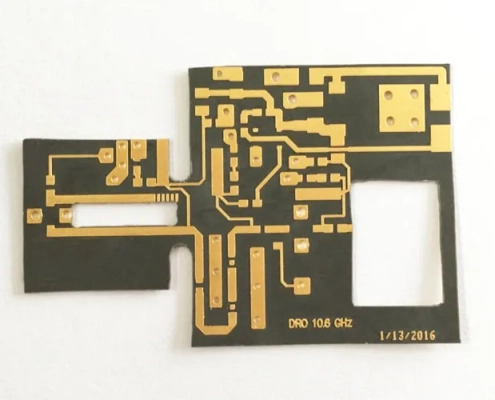Rogers 5880: High-Frequency Performance at its Best
When it comes to high-frequency PCB designs, not all materials are created equal. Rogers 5880, also known as Rogers RT/duroid® 5880, stands out as a premium substrate specifically engineered for RF (Radio Frequency) and microwave applications. With its low dielectric loss, stable dielectric constant, and superior mechanical properties, it’s a go-to material for industries where performance at gigahertz frequencies is non-negotiable.
What is Rogers 5880?
Rogers 5880 is a PTFE (Polytetrafluoroethylene)-based composite material filled with ceramic particles. This unique composition provides exceptional electrical and mechanical stability, making it ideal for microwave and high-frequency PCB designs.
Unlike conventional PCB materials like FR-4, Rogers 5880 offers minimal dielectric loss, ensuring signal integrity even at extremely high frequencies. This property is particularly beneficial for designs that require low insertion loss and tight impedance control.
| Property | Value |
|---|---|
| Dielectric Constant (Dk) | 2.20 ± 0.02 (at 10 GHz) |
| Dissipation Factor (Df) | 0.0009 (at 10 GHz) |
| Thickness Options | 0.127 mm – 3.175 mm |
| Thermal Coefficient (Dk) | -125 ppm/°C |
| Moisture Absorption | 0.02% |
| Operating Temperature | -50°C to +250°C |
The Rogers 5880 Dielectric Constant (Dk) of 2.20 ± 0.02 at 10 GHz is a standout feature, providing low signal loss and high stability in demanding RF and microwave applications. This makes it an ideal choice for high-frequency circuits requiring precision and minimal signal attenuation.
- Ultra-Low Dielectric Loss: Ideal for high-frequency and microwave circuits.
- Stable Dielectric Constant: Minimal variation across temperature and frequency ranges.
- Moisture Resistance: Excellent for harsh environments and aerospace applications.
- Mechanical Flexibility: Suitable for flexible and multi-layer designs.
- Thermal Performance: Supports high-power applications due to its low thermal coefficient.
The high-performance nature of Rogers 5880 makes it indispensable across multiple industries, including:
- RF and Microwave PCBs: Power amplifiers, antennas, and microwave filters.
- Aerospace and Defense: Radar systems, satellite communications, and avionics.
- Automotive Radar: Critical in 77 GHz radar applications for advanced driver-assistance systems (ADAS).
- Medical Devices: Used in precision imaging and diagnostic equipment.
- 5G and mmWave Technology: Essential for high-speed data transmission in next-generation communication networks.
When designing with Rogers 5880, specific factors must be considered to optimize performance:
- Trace Width Calculation: Ensure proper impedance matching based on dielectric constant and frequency.
- Via Design: Use back-drilled or blind vias to reduce signal loss and maintain signal integrity.
- Material Handling: PTFE composites require specialized handling during drilling and plating processes.
- Layer Stack-Up: Carefully plan the multi-layer stack-up to maintain consistent electrical performance.
Contact Us NOW
FAQs About Rogers 5880
What is Rogers 5880?
Rogers 5880 is a high-performance circuit material known for its exceptional electrical properties, widely used in the electronics industry for high-frequency applications.
What is the dielectric constant of Rogers 5880?
The dielectric constant of Rogers 5880 typically ranges around 2.2, making it suitable for efficient signal transmission in high-frequency circuits.
How thick is Rogers 5880 substrate?
Rogers 5880 is available in various thickness options, including 0.020 inches (0.508 mm), 0.030 inches (0.762 mm), and 0.060 inches (1.524 mm), among others, to accommodate different design requirements and applications.
What is the dielectric constant of Rogers RT 5880?
Rogers RT 5880 is a variant of Rogers 5880 known for its enhanced thermal conductivity. While specific dielectric constant values may vary, Rogers RT 5880 typically maintains similar electrical properties to Rogers 5880.
What are the key characteristics of Rogers 5880?
Rogers 5880 is characterized by its low dielectric constant, low loss tangent, exceptional dimensional stability, and ease of processing, making it ideal for high-frequency electronic applications.
In which industries is Rogers 5880 commonly used?
Rogers 5880 finds applications in various industries, including telecommunications, aerospace, automotive, medical devices, and defense, where high-frequency performance and reliability are critical.
What are the advantages of using Rogers 5880?
The advantages of Rogers 5880 include high-performance electrical properties, low signal loss, dimensional stability, and compatibility with diverse manufacturing processes, contributing to reliable operation in demanding electronic systems.
How does Rogers 5880 contribute to communication systems?
Rogers 5880 enables efficient signal transmission and reception in communication systems, enhancing coverage, data rates, and network reliability in telecommunications infrastructure, wireless networks, and satellite communications.
What role does Rogers 5880 play in radar systems?
In radar systems, Rogers 5880 facilitates precise signal processing, target detection, and tracking, thanks to its low loss and high-frequency performance, making it indispensable for military, automotive, and weather radar applications.
Can Rogers 5880 be used in medical devices?
Yes, Rogers 5880 is utilized in medical devices such as MRI machines, RF ablation systems, and diagnostic equipment, where its low loss and high-frequency capabilities enable accurate signal transmission and reception, contributing to improved diagnostics and treatments.


